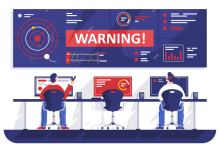
Companies often exhibit a failure of imagination when implementing new technology. Leadership can readily imagine the power of the new tools but can’t extend that vision to the people who’ll use and derive value from the tools on a daily basis. They think you just get started and it will all work out (a.k.a. “good people find a way”). It places contact center management in the position of scrambling for resources using one of the following scenarios.
In larger organizations, a centralized pool of Corporate Resources often assumes responsibility for support in the form of Business Intelligence or Learning and Development (L&D) groups. These folks tend to be generalists who support a broad range of business units and applications. While having some resource beats no resources, the diffuse attention and lack of contact center expertise may compromise the quality, quantity, and consistency of support the center receives.
In a Line of Business Resource model, support staff tends to be allocated in direct proportion to each unit’s contribution to the bottom line. Small centers may find themselves in the precarious position of scraping for attention or, sadly, giving up and going unnoticed, thereby underutilizing the tools. Astute managers look for opportunities to share resources with comparably-sized business units or fund a piece of an analyst situated in a larger group.
The all-too-common No Resource scenario carries an expectation that technology use and optimization is something that can be folded seamlessly into an existing position. It’s a common occurrence in smaller centers and a great challenge to overcome. If Supervisors (or Managers) prioritize these responsibilities, it comes at the cost of their main roles in coaching and development, which in turn impacts employee engagement and attrition. If they give technology short-shrift, then they short change the value they get from these tools.
In any of these scenarios, loss of trained resources imperils the ongoing benefits that technology can deliver. Companies are often reticent to backfill these jobs and may delegate the responsibility to someone else (who is probably full up with other tasks!) and/or be slow in training a replacement.
Beyond the obvious time management issues with grafting analyst responsibilities onto frontline leadership jobs, technology users must have an aptitude for, and interest in, the tools to which they are assigned. Someone with strengths as a Supervisor (e.g., people-oriented, love to develop staff) may not have the same level of expertise in doing analysis (do you know anyone who says, “I don’t do numbers!”?).
Contact center leaders routinely wear many hats, especially in small centers. They prioritize and perform triage constantly. They can’t do it all. It’s time to dispense with the magical thinking that technology takes care of itself, or that good people will simply find a way.
The good news: Technology is getting easier to manage. Improvements in user interfaces (UIs) enable frontline staff to offload some of the administrative functions, leaving analysts free to focus on more sophisticated inquiries and deeper dives. These UIs are more intuitive and require less training for technically astute users. Out-of-the-Box (OOTB) functionality helps companies go farther, faster – whether pre-built starters, “wizards,” and/or readily configurable templates.
More good news: Each new technology does not have to have its own dedicated resource. When you figure out which roles you need based on the technology you have or are pursuing, you could create a combined analytical role or tap others for part of the function. Some examples:
- Business Analyst that does WFM activities and reporting and analytics role
- QM/VoC that can take on a higher ratio of agents when Supervisors do part of the reviews and deliver the coaching
- A Knowledge Manager who is also responsible for process optimization
In sum: As the contact center technology industry advances with increasingly powerful and diverse tools to help your center meet its goals, keep in mind it’s not just about the technology—you need people.



